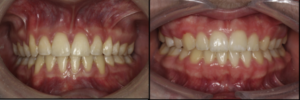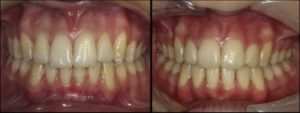Does substituting premolars for canines look good?
Occasionally, we decide that an impacted canine cannot be aligned and decide to remove it and replace it with a first premolar. This study provides great information on the aesthetics of this approach.
While contemporary treatment mechanics make alignment of most impacted canines possible, there are patients for whom we should consider removal of the impacted canine. Good examples are patients with arch-length discrepancy, good contact between the lateral incisor and first premolar and palatally placed canines that are very displaced. Despite the publication of heroic case reports showing canines going on a long journey of guided eruption. We should consider if this treatment is always in the best interests of the patient.
The counterargument to canine removal is based around aesthetics and occlusal function. Unfortunately, these are at the level of case report and expert opinion. As a result, I thought that this new study was timely. A team from Manchester and Chesterfield, North of England did this study. They looked at the aesthetic appearance of orthodontic patients treated by canine extraction.
The AJO-DDO published the paper.
Badri Thiruventakachari et al,
Am J Orthod Dentofacial Orthop 2017;152:509-15
They did the study to ask this question;
“Is there a difference in the perceptions of patients smiles treated by extracting either maxillary canines or premolars, as judged by orthodontists, dentists and lay people”?
What did they do?
They did a retrospective study and looked at sets of patients records selected from one orthodontic department.
The authors selected patients who had unilateral or bilateral extraction of maxillary canines and compared them to a group who had unilateral or bilateral extraction of maxillary first premolars.
They had finished all the patients to a high occlusal standard with PAR scores less than 5.
They took facial and anterior teeth photographs, blinded them and randomly showed them to a rating panel. The panel included 10 orthodontists, 10 dentists and 10 lay people. The panel rated the attractiveness of the photographs using a 10 point Likert scale. Here are examples of the anterior intra oral pictures that they used.


They calculated the mean scores for each photograph and compared the groups using the relevant statistical tests.
What did they find?
They included 24 patients in the canine extraction group and 24 in the control group. The canine extraction group included 14 unilateral and 10 bilateral extractions.
They found that there was no difference in the aesthetic ratings between the canine and premolar extraction groups. The mean difference in scores was on 0.33 (95% Ci -0.26-0.91). There were also no clinically significant differences between the rater groups.
They concluded:
“We found no difference in the smile attractiveness of patients treated with extraction of canines or first premolars.
“Operators should discuss the removal of canines where this approach has advantages”.
What did I think?
I will declare an interest, I know this team well and we are close colleagues. However, I thought that this was a clinically relevant study that provides us with useful information.
I will start by having a look at the potential shortcomings of their methods. Firstly, they collected a retrospective study of selected cases that they finished to a high standard. This means that the findings are only relevant to well treated cases. A better study methodology would be to enrol patients into a trial and randomly allocate them to canine removal or not. This would then include the results of treatment that is not successful. However, this type of study would take many years and involve several centres because of the low numbers of patients who would satisfy the inclusion criteria. As a result, I feel that they have done the best type of study.
The other issue is that the photographs are “still life” and not dynamic. We may consider this to be problem. Again, I feel that this is the best that can be done using routine records.
Finally, they did not carry out a sample size calculation. This means that the study may not have enough power to detect a difference between the groups. However, when I looked at the effect size, it was very small. This provides me with some reassurance, nevertheless, we should bear this in mind when we evaluate the findings.
My conclusions
I feel that this study is important because it is the first study that has evaluated this question and the findings are clinically useful. Some may be critical and point out they did not evaluate occlusal function and canine protected occlusion. But the evidence behind these concepts is very weak. I expect that we will get a lot of discussion about this!
This project certainly reassures me when I decide that it is the best interests of the patient to extract the permanent canine and replace this tooth with a premolar.

Emeritus Professor of Orthodontics, University of Manchester, UK.
Well said. It’s time to rethink the mythical status of the canine and consider the time in treatment, pain, suffering and less than ideal results we often inflict on patients through herodonticly trying to bring in seriously ectopic canines despite the scant evidence as to their value/necessity in the occlusal scheme. Both the article and your evaluation thereof are well written, timely and relevant. Thanks for sharing. This is a conversation that we orthodontists desperately need to have.
It seems to me that, in addition to the differences in the occlusal function of these two teeth, an important element in this aesthetic analysis is missing: the radicular morphological difference (conical root versus roots with parallelepipedic global volume or even with very vestibular mesio vestibular apex.
This element can cause periodontal fenestration and / or modification of the general inclination of the tooth and therefore of the general aesthetic of this sector.
I admit a personal interest as my own U.3’s were extracted a long time ago. The contacts between U.2’s and U.4’s are not good (mesial ‘groove’ in U’4’s means constant TePe’s). I consider my own perio awareness possibly better than the average…
Aesthetically – possibly loss of canine eminence leading to an ‘older looking face’. Anyone really bothered (I’m not!) could get some dermal fillers.
Good study, IMHO.
This is an interesting study. I think the aesthetic issue is mostly irrelevant since the human eye can perceive teeth by block of four teeth at a time, Therefore, you have to move your eyes to evaluate both sides, which is rarely done by the layman on the street. The root anatomy and the crown anatomy of the first bicuspid should be more important in the decision (after the possibility to guide the canine in place without any risk to the adjacent teeth) of sacrificing the canine.
We all know that good tooth substitution outcomes times are possible (even in zero treatment time) because nature provides this sometimes without an orthodonist being involved.
I think that knowing the above is why we would attempt this treatment. This study only confirms that – in certain circumstances – this strategy is reasonable.
But a lot of information is still missing from our treatment decision algorithm, to know when this nice outcome is likely or when it is not. I think this is the hard question.
Good study and relevant commentary. However, as ‘beauty lies in the beholder’s eye(and mind)’- the fact that orthodontists, dentists an lay people did not notice, clinically or statistically significant difference between the ‘canined’ and ‘canine substituted’ groups is not surprising. One may recall the similar midline studies(Kokich et al) where even gross midline shifts of even upper dentition passed unnoticed! ( Giving the Tom Cruise example). At the cost of oversimplification, can we say ‘looking good’ (in posed photographs)alone cannot be a parameter of professional orthodontics ?
Has anyone done a similar study with canines substituting for lateral incisors?
Stephen Murray
Swords Orthodontics
In response to Stephen’s comment the answer is yes:
Qadri S, Parkin NA, Benson PE. Space closing versus space opening for bilateral missing upper laterals – aesthetic judgments of laypeople: a web-based survey. J Orthod 2016; 43: 137-146. 10.1080/14653125.2016.1145880
thanks for that!
I find the older I get the more I state even Peter could not walk on water. I agree that the case reports are often impressive moving canines “yards and yards” at the expense of the patient who has extended treatment. Sometimes the cuspids are ankylosed or mechanically locked and after the premolar removed, the patient needs to have the almighty cuspid removed and the patient, after extended treatment time, later in life needs an implant. Guys & Girls cuspids are not sacred! I find it critical to really work with the Oral surgeon and have a bony path cut to facilitate the movement of the impacted cuspids directly into the arch.
I usually find that patients/parents are receptive to tooth substitution solutions for congenitally missing or hopelessly impacted teeth. The problem “customer” is the general dentist who thinks that the canines are sacrosanct and a patient is forever harmed if we remove them for good reason. Don’t even get a prosthodontist started on this subject.
Hello Dr. But wouldn’t there be a gap that can be obvious on smiling if the premolar is removed to replace the canine?